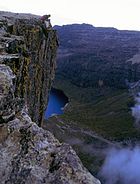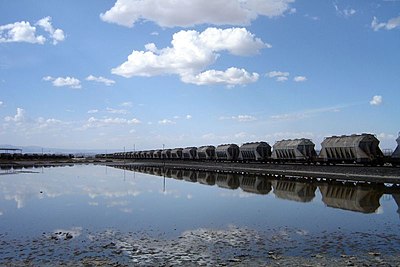Portal:Kenya

Introduction  Kenya, officially the Republic of Kenya (Swahili: Jamhuri ya Kenya), is a country in East Africa. With a population of more than 47.6 million in the 2019 census, Kenya is the 28th-most-populous country in the world and 7th most populous in Africa. Kenya's capital and largest city is Nairobi, while its oldest and second-largest city, is the major port city of Mombasa, situated on Mombasa Island in the Indian Ocean and the surrounding mainland. Mombasa was the capital of the British East Africa Protectorate, which included most of what is now Kenya and southwestern Somalia, from 1889 to 1907. Other important cities include Kisumu and Nakuru. Kenya is bordered by South Sudan to the northwest, Ethiopia to the north, Somalia to the east, Uganda to the west, Tanzania to the south, and the Indian Ocean to the southeast. Kenya's geography, climate and population vary widely, ranging from cold snow-capped mountaintops (Batian, Nelion and Point Lenana on Mount Kenya) with vast surrounding forests, wildlife and fertile agricultural regions to temperate climates in western and rift valley counties and further on to dry less fertile arid and semi-arid areas and absolute deserts (Chalbi Desert and Nyiri Desert). Kenya's earliest inhabitants were hunter-gatherers, like the present-day Hadza people. According to archaeological dating of associated artifacts and skeletal material, Cushitic speakers first settled in Kenya's lowlands between 3,200 and 1,300 BC, a phase known as the Lowland Savanna Pastoral Neolithic. Nilotic-speaking pastoralists (ancestral to Kenya's Nilotic speakers) began migrating from present-day South Sudan into Kenya around 500 BC. Bantu people settled at the coast and the interior between 250 BC and 500 AD. European contact began in 1500 AD with the Portuguese Empire, and effective colonisation of Kenya began in the 19th century during the European exploration of the interior. Modern-day Kenya emerged from a protectorate established by the British Empire in 1895 and the subsequent Kenya Colony, which began in 1920. Numerous disputes between the UK and the colony led to the Mau Mau revolution, which began in 1952, and the declaration of independence in 1963. After independence, Kenya remained a member of the Commonwealth of Nations. The current constitution was adopted in 2010 and replaced the 1963 independence constitution. Kenya is a presidential representative democratic republic, in which elected officials represent the people and the president is the head of state and government. Kenya is a member of the United Nations, the Commonwealth, World Bank, International Monetary Fund, World Trade Organization, COMESA, International Criminal Court, as well as other international organisations. With a GNI of 1,840, Kenya is a lower-middle-income economy. Kenya's economy is the second largest in eastern and central Africa, after Ethiopia, with Nairobi serving as a major regional commercial hub. Agriculture is the largest sector; tea and coffee are traditional cash crops, while fresh flowers are a fast-growing export. The service industry is also a major economic driver, particularly tourism. Kenya is a member of the East African Community trade bloc, though some international trade organisations categorise it as part of the Greater Horn of Africa. Africa is Kenya's largest export market, followed by the European Union. (Full article...)
Selected article - Selected picture -Selected location - Meru County is one of the 47 counties of Kenya, located in the former Eastern Province. In 1992, it was split from the large Meru District, along with Meru North District, Meru South District, and Tharaka-Nithi County. Its capital and largest town is Meru. Its population is 1,356,301 as of 2009. (Read more...) This is a Good article, an article that meets a core set of high editorial standards.
Msambweni (meaning "land of Msambwe") in Swahili) is a small fishing town and constituency in Kwale County of southeastern Kenya, formerly in Kwale District of Coast Province. The origin of the name, Msambwe (plural Misambwe) is a hardy and wild fruits (sambwe) tree indigenous to Msambweni. A few remnants of the Msambwe trees are still existing at Mkunguni Beach, Sawa Sawa Village. By road, Msambweni is 55.4 kilometres (34.4 mi) south of Mombasa and 46.5 kilometres (28.9 mi) northeast of Lunga Lunga on the Tanzanian border. As of 2009, the town had a population of 11,985 people. Fishing is the primary source of income, although coconut palm, buxa coloring, cashew nuts and fruits are produced for trade. Because of its reef and extensive beaches, the snorkeling industry is gaining in popularity in Msambweni, and holiday cottages and hotels have sprung up in the area, such as the Msambweni Beach House. The town is noted for its leprosarium and contains the Msambweni District Hospital. The Koromojo Dam is immediately north of the town. (Full article...)Selected biography -
Amina Chawahir Mohamed Jibril (Somali: Aamina Maxamed Jibriil; Arabic: أمينة محمد جبريل), born 5 October 1961, is a former Kenyan cabinet secretary, lawyer and a diplomat of Somali descent. She is the immediate former Cabinet Secretary for Sports, Heritage and Culture in Kenya. She previously served as chairwoman of the International Organization for Migration and the World Trade Organization's General Council, as well as Assistant Secretary-General and Deputy Executive Director of the United Nations Environment Programme. She served as the Cabinet Secretary for Foreign Affairs of Kenya from May 2013 to February 2018, when President Uhuru Kenyatta, after re-election, moved her to the Education docket. In March 2019, she was moved to the Sports Ministry replacing Rashid Echesa. The KNEC Director, George Magoha replaced her in the Education docket. (Full article...)
Related portalsDid you know (auto-generated) -
In the news
Wikinews Kenya portal
Selected panorama -Panorama of Lake Bogoria, Baringo County
General images -The following are images from various Kenya-related articles on Wikipedia.
Topics in KenyaCategoriesAssociated WikimediaThe following Wikimedia Foundation sister projects provide more on this subject:
Discover Wikipedia using portals |










































